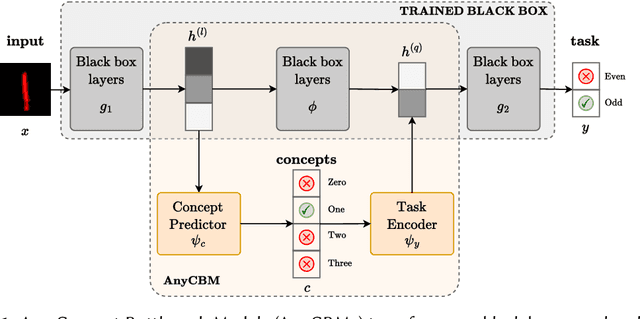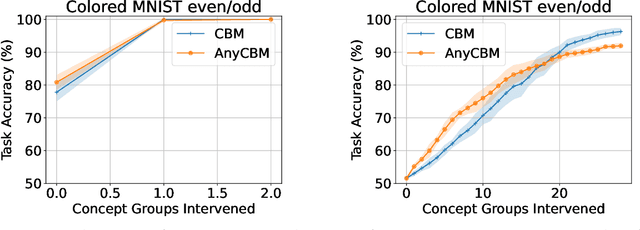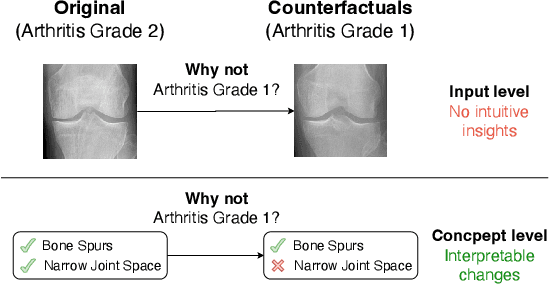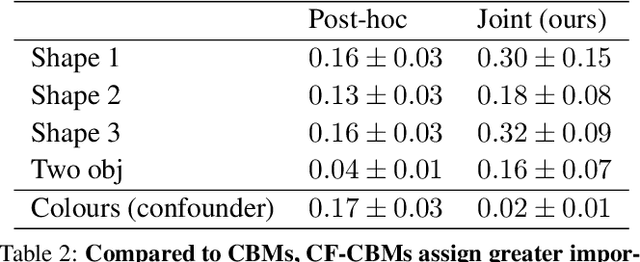Francesco Giannini
Faculty of Sciences, Scuola Normale Superiore, Pisa
If Concept Bottlenecks are the Question, are Foundation Models the Answer?
Apr 29, 2025Abstract:Concept Bottleneck Models (CBMs) are neural networks designed to conjoin high performance with ante-hoc interpretability. CBMs work by first mapping inputs (e.g., images) to high-level concepts (e.g., visible objects and their properties) and then use these to solve a downstream task (e.g., tagging or scoring an image) in an interpretable manner. Their performance and interpretability, however, hinge on the quality of the concepts they learn. The go-to strategy for ensuring good quality concepts is to leverage expert annotations, which are expensive to collect and seldom available in applications. Researchers have recently addressed this issue by introducing "VLM-CBM" architectures that replace manual annotations with weak supervision from foundation models. It is however unclear what is the impact of doing so on the quality of the learned concepts. To answer this question, we put state-of-the-art VLM-CBMs to the test, analyzing their learned concepts empirically using a selection of significant metrics. Our results show that, depending on the task, VLM supervision can sensibly differ from expert annotations, and that concept accuracy and quality are not strongly correlated. Our code is available at https://github.com/debryu/CQA.
Deferring Concept Bottleneck Models: Learning to Defer Interventions to Inaccurate Experts
Mar 20, 2025Abstract:Concept Bottleneck Models (CBMs) are machine learning models that improve interpretability by grounding their predictions on human-understandable concepts, allowing for targeted interventions in their decision-making process. However, when intervened on, CBMs assume the availability of humans that can identify the need to intervene and always provide correct interventions. Both assumptions are unrealistic and impractical, considering labor costs and human error-proneness. In contrast, Learning to Defer (L2D) extends supervised learning by allowing machine learning models to identify cases where a human is more likely to be correct than the model, thus leading to deferring systems with improved performance. In this work, we gain inspiration from L2D and propose Deferring CBMs (DCBMs), a novel framework that allows CBMs to learn when an intervention is needed. To this end, we model DCBMs as a composition of deferring systems and derive a consistent L2D loss to train them. Moreover, by relying on a CBM architecture, DCBMs can explain why defer occurs on the final task. Our results show that DCBMs achieve high predictive performance and interpretability at the cost of deferring more to humans.
Logic Explanation of AI Classifiers by Categorical Explaining Functors
Mar 20, 2025Abstract:The most common methods in explainable artificial intelligence are post-hoc techniques which identify the most relevant features used by pretrained opaque models. Some of the most advanced post hoc methods can generate explanations that account for the mutual interactions of input features in the form of logic rules. However, these methods frequently fail to guarantee the consistency of the extracted explanations with the model's underlying reasoning. To bridge this gap, we propose a theoretically grounded approach to ensure coherence and fidelity of the extracted explanations, moving beyond the limitations of current heuristic-based approaches. To this end, drawing from category theory, we introduce an explaining functor which structurally preserves logical entailment between the explanation and the opaque model's reasoning. As a proof of concept, we validate the proposed theoretical constructions on a synthetic benchmark verifying how the proposed approach significantly mitigates the generation of contradictory or unfaithful explanations.
Mathematical Foundation of Interpretable Equivariant Surrogate Models
Mar 03, 2025Abstract:This paper introduces a rigorous mathematical framework for neural network explainability, and more broadly for the explainability of equivariant operators called Group Equivariant Operators (GEOs) based on Group Equivariant Non-Expansive Operators (GENEOs) transformations. The central concept involves quantifying the distance between GEOs by measuring the non-commutativity of specific diagrams. Additionally, the paper proposes a definition of interpretability of GEOs according to a complexity measure that can be defined according to each user preferences. Moreover, we explore the formal properties of this framework and show how it can be applied in classical machine learning scenarios, like image classification with convolutional neural networks.
Neural Interpretable Reasoning
Feb 17, 2025

Abstract:We formalize a novel modeling framework for achieving interpretability in deep learning, anchored in the principle of inference equivariance. While the direct verification of interpretability scales exponentially with the number of variables of the system, we show that this complexity can be mitigated by treating interpretability as a Markovian property and employing neural re-parametrization techniques. Building on these insights, we propose a new modeling paradigm -- neural generation and interpretable execution -- that enables scalable verification of equivariance. This paradigm provides a general approach for designing Neural Interpretable Reasoners that are not only expressive but also transparent.
Interpretable Concept-Based Memory Reasoning
Jul 22, 2024



Abstract:The lack of transparency in the decision-making processes of deep learning systems presents a significant challenge in modern artificial intelligence (AI), as it impairs users' ability to rely on and verify these systems. To address this challenge, Concept Bottleneck Models (CBMs) have made significant progress by incorporating human-interpretable concepts into deep learning architectures. This approach allows predictions to be traced back to specific concept patterns that users can understand and potentially intervene on. However, existing CBMs' task predictors are not fully interpretable, preventing a thorough analysis and any form of formal verification of their decision-making process prior to deployment, thereby raising significant reliability concerns. To bridge this gap, we introduce Concept-based Memory Reasoner (CMR), a novel CBM designed to provide a human-understandable and provably-verifiable task prediction process. Our approach is to model each task prediction as a neural selection mechanism over a memory of learnable logic rules, followed by a symbolic evaluation of the selected rule. The presence of an explicit memory and the symbolic evaluation allow domain experts to inspect and formally verify the validity of certain global properties of interest for the task prediction process. Experimental results demonstrate that CMR achieves comparable accuracy-interpretability trade-offs to state-of-the-art CBMs, discovers logic rules consistent with ground truths, allows for rule interventions, and allows pre-deployment verification.
AnyCBMs: How to Turn Any Black Box into a Concept Bottleneck Model
May 26, 2024



Abstract:Interpretable deep learning aims at developing neural architectures whose decision-making processes could be understood by their users. Among these techniqes, Concept Bottleneck Models enhance the interpretability of neural networks by integrating a layer of human-understandable concepts. These models, however, necessitate training a new model from the beginning, consuming significant resources and failing to utilize already trained large models. To address this issue, we introduce "AnyCBM", a method that transforms any existing trained model into a Concept Bottleneck Model with minimal impact on computational resources. We provide both theoretical and experimental insights showing the effectiveness of AnyCBMs in terms of classification performances and effectivenss of concept-based interventions on downstream tasks.
Explainable Malware Detection with Tailored Logic Explained Networks
May 05, 2024Abstract:Malware detection is a constant challenge in cybersecurity due to the rapid development of new attack techniques. Traditional signature-based approaches struggle to keep pace with the sheer volume of malware samples. Machine learning offers a promising solution, but faces issues of generalization to unseen samples and a lack of explanation for the instances identified as malware. However, human-understandable explanations are especially important in security-critical fields, where understanding model decisions is crucial for trust and legal compliance. While deep learning models excel at malware detection, their black-box nature hinders explainability. Conversely, interpretable models often fall short in performance. To bridge this gap in this application domain, we propose the use of Logic Explained Networks (LENs), which are a recently proposed class of interpretable neural networks providing explanations in the form of First-Order Logic (FOL) rules. This paper extends the application of LENs to the complex domain of malware detection, specifically using the large-scale EMBER dataset. In the experimental results we show that LENs achieve robustness that exceeds traditional interpretable methods and that are rivaling black-box models. Moreover, we introduce a tailored version of LENs that is shown to generate logic explanations with higher fidelity with respect to the model's predictions.
Climbing the Ladder of Interpretability with Counterfactual Concept Bottleneck Models
Feb 02, 2024



Abstract:Current deep learning models are not designed to simultaneously address three fundamental questions: predict class labels to solve a given classification task (the "What?"), explain task predictions (the "Why?"), and imagine alternative scenarios that could result in different predictions (the "What if?"). The inability to answer these questions represents a crucial gap in deploying reliable AI agents, calibrating human trust, and deepening human-machine interaction. To bridge this gap, we introduce CounterFactual Concept Bottleneck Models (CF-CBMs), a class of models designed to efficiently address the above queries all at once without the need to run post-hoc searches. Our results show that CF-CBMs produce: accurate predictions (the "What?"), simple explanations for task predictions (the "Why?"), and interpretable counterfactuals (the "What if?"). CF-CBMs can also sample or estimate the most probable counterfactual to: (i) explain the effect of concept interventions on tasks, (ii) show users how to get a desired class label, and (iii) propose concept interventions via "task-driven" interventions.
Relational Concept Based Models
Aug 23, 2023



Abstract:The design of interpretable deep learning models working in relational domains poses an open challenge: interpretable deep learning methods, such as Concept-Based Models (CBMs), are not designed to solve relational problems, while relational models are not as interpretable as CBMs. To address this problem, we propose Relational Concept-Based Models, a family of relational deep learning methods providing interpretable task predictions. Our experiments, ranging from image classification to link prediction in knowledge graphs, show that relational CBMs (i) match generalization performance of existing relational black-boxes (as opposed to non-relational CBMs), (ii) support the generation of quantified concept-based explanations, (iii) effectively respond to test-time interventions, and (iv) withstand demanding settings including out-of-distribution scenarios, limited training data regimes, and scarce concept supervisions.
 Add to Chrome
Add to Chrome Add to Firefox
Add to Firefox Add to Edge
Add to Edge